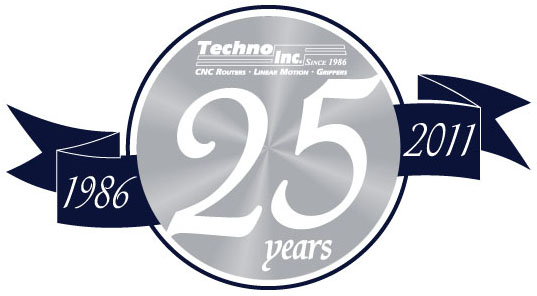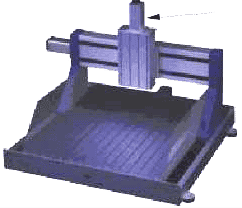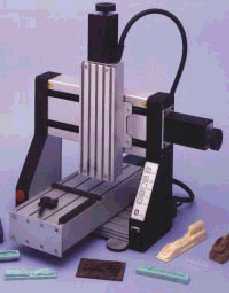


CNC Router
Educational Success Stories
 Affordable Precision Educational CNC Router Affordable Precision Educational CNC RoutereMail us at technosales@technocnc.com |
|
First, Boeing's designers create the plan, then the rest of the company works on the challenge of bringing their vision to life. For example, Boeing decided the way to make the strongest possible wing spars (the internal structure of the wing) and wing skins (the outer surface) was to do each as a continuous piece. This design can withstand constant stress better than many previous ones. Traditionally, wing spars and wing skins have been manufactured in many small parts and then assembled. Every attachment point has a possibility of fatigue and failure that is higher than the rest of the structure. In theory, wing spars and wing skins made in one continuous piece sound great, but they are two of the largest parts on some of the largest airplanes built today. They require raw blanks of metal measuring up to 105 feet by 21 feet. That's a lot of aluminum! To get a perspective on the size of blank needed, a college basketball court is 90 feet long and 50 feet wide. To compound the difficulty, spars and skins are also highly sculptured 3-D surfaces requiring precision tolerances. The solution to the problem of accurately machining these huge pieces of raw material took some innovative thinking and resulted in one of the world's largest Computer Numeric Control (CNC) machines. A standard CNC mill has a fixed length arm extending over a table. The table can move the stock in two directions, referred to as the X- and Y- axes. To cut a wing skin, the spindle would have to hang over 12 feet from the column, losing precision and strength. Boeing's answer was to build a completely different CNC mill configuration, the gantry mill.
Boeing contracted Ingersoll Rand to build these gantry machines. Instead of one vertical column supporting the spindle and cutter, there are two on the gantry. The spindle rides back and forth and up and down on the cross bar, and the whole gantry rides back and forth on rails embedded in the platform. The gantry's lack of vertical column gives it much more flexibility for cutting and fixturing various stock sizes. Gantry mills have long been a standard in industry for cutting large parts, but monsters of this scale had never been made. This design is so successful that 22 of these giant machines reside in Boeing's Auburn Valley plant alone. Theory and design are exciting, important, and are often pushed to the forefront of manufacturing; yet the most important issue that drives manufacturing is the product itself. The finished part in hand generates the reward, and makes the whole process worth the effort. The goal of producing the best plane on the market drove the designers to make the specifications that forced a new manufacturing solution. When this attitude is applied to educational projects, the results can be just as fruitful. Creation and ownership are two successful student motivations. Instructors are consistently successful in coaxing their students through long educational processes when the end result is viewed as desirable by the student. Over 1500 secondary and postsecondary schools annually purchase tabletop CNC milling machines. Some schools have five or six machines. Why? Because students want to own what they design and produce. Many things that students can imagine and design are difficult or impossible to make manually. Computer- controlled machines can bring their ideas to reality. Teachers can effectively harness this tool to motivate students and drive many divergent curriculums. What Are Schools Doing With CNC Milling Machines? First, the student uses CAD to create the geometry for a design. Then they generate the toolpath and NC-Code for the CNC mill in the CAM software. Finally, when the NC-Code is communicated to the CNC Mill, the student's design is accurately cut out of an acrylic blank. Beyond providing simple aesthetic satisfaction, these activities expose students to high tech manufacturing job opportunities and are good practical problem-solving experiences. Each week, for example, students can concentrate on a different subject to make more sophisticated parts. Mr. Pete Sorinson and his colleagues at Lake Washington HS, Kirkland, WA use their CNC machines in a number of different courses. CAD class uses it to produce the prototypes that are designed in the mechanical CAD curriculum. Designing and producing a part on a CNC machine gives real application experience for a mechanical CAD student. It is comparable to architectural CAD students building a balsa stick frame house. The Technology Exposure class is given the challenge of making an assembly out of Legos that will perform a specific task. But the solution requires the design and production of a missing part. This part must interface with the standard Lego components. For this exercise, students work in teams to learn group dynamics and problem-solving. Or consider Mr. Bob Koll, of Junita HS, Kirtland, WA. This year, he and his class were dissatisfied with the wheels provided in their CO2 car kits, so they designed new wheels using CAD/CAM software. They cut the wheel pattern out of wax on the CNC mill and used a cold mold process to produce the wheels. They tried using plastics of different resiliencies to get the performance they wanted. Students and instructors get excited with the possibility of producing commercial quality products on the CNC mill, and are creating articulations among marketing, CAD design, and technology classes for the purpose of establishing student companies to sell student creations. The CNC mill allows intricate items to be mass-produced from a single design. How To Buy An Entry-Level CNC Milling Machine So, your supervisor has given you the go-ahead to purchase a piece of CNC equipment. Of course, as the euphoria of the news wears off, you realize there are some serious questions that need answers. First of all: To help answer those questions, here are some things to consider: Is this to be a precision machining program or do you just want to explore the basics and integrate the curriculum with math and science? 1. Is the machine cast iron, aluminum, or polymer composite? Cast iron construction offers a higher level of rigidity and longer wear, but is heavy. Will you move the machine around a lot? If you will, consider aluminum, it is lighter and almost as rigid. The polymer composites are light, also. 2. Does it use industry standard ISO G&M codes? Fanuc® is currently industry standard in the US and many parts of the world. 3. Stepper or servos, what's the difference? The axis motor drive types on the market are called stepper and servos. Servos are more accurate than steppers and cost much more. The true servo system strength is that the system checks its position at each move against an independent measuring device, such as a glass scale. This is a closed loop system. Steppers are open loop systems executing a chain of commands without checking their position against an independent device. There is no question that servos are more accurate, however, steppers could be adequate, it depends on how repeatably accurate your final product needs to be. 4. Does it provide Unlimited Program Lengths through drip feed capability? Precision machining may call for more complicated, longer programs. Drip feed allows longer programs to be run. 5. How big is the work envelope? This is the total area that the mill can possibly cut. Perhaps a more accurate definition could be the largest possible part that could be cut. Is it big enough to accommodate the work you envision? Many small CNC machines boast Y-axis travels of 4+ inches, when in reality it is much less if a vice or stock over 2" high is used. If you want to use clamps, t-nuts, vices, fixtures, vacuum tables, etc., make certain they fit in the work area. 6. What is the axis feed rate? Feed rate is how fast a machine can move while cutting stock. High feed rates might be crucial to the success of your program, as the production schedule usually must fit into a 50 minute class period. For example, the Techno DaVinci's maximum machining feed rate is 140 IPM (inches per minute), while some small CNC mill's maximum machining feed rates are in the 16- 30 IPM range. You need to determine how long it will take to mill the pieces you plan to make. If a CO2 car body takes 15-20 minutes to machine at 80 IPM; at 16 IPM, one car could take well over a class period to complete. How many students do you have? 7. How about spindle speed? For nonferrous metals, wood plastics, and prototype material, high spindle speeds are recommended. Without high spindle speeds on soft materials, the flutes on the endmills will load up with stock and ruin the part. The only way to avoid gumming up the cutters in soft materials at low spindle rpm is to lower the feed rate. Is that a problem? See #6 above to determine if it is.
Something simpler? 1. Are there easy-to-use and complete curriculums available? The curriculum needs to be something you and your students feel comfortable with and that will meet sound educational objectives. Does it integrate math, science and technology concepts? Are the suggested activities engaging to students? It might be a good idea to recruit some student evaluators for this part. 2. Is the machine easy-to-use? Does it have a "Machine Hard Home"? Does it require additional interface cards to be installed or is it a direct RS-232 connection? A machine that does all this will be easier for the instructor to supervise. Part offsets can be saved as files and recalled quickly when the machine is turned on. This will save valuable "on-task" time for students and instructors. Besides, that's how it works in industry. Additional cards that have to be installed in the computer limit the flexibility of being able to use other computers to drive the mill. 3. Are limit switches on each axis for greater safety and control? Is it fully enclosed with an interlocking guard? Is it well lighted? Can you see the work in progress and still be protected? Obviously, safety for the operator and for the machine are important features.
|
 Techno is celebrating over 25 years of CNC technology
expertise. Our Educational sector provides industrial quality products
at educational prices with a network of award-winning Educators. We can
provide CNC Curriculums, CNC Projects, Technical Information and
Packages for any educational classroom.
Techno is celebrating over 25 years of CNC technology
expertise. Our Educational sector provides industrial quality products
at educational prices with a network of award-winning Educators. We can
provide CNC Curriculums, CNC Projects, Technical Information and
Packages for any educational classroom.
 Don't forget the
computer program
Don't forget the
computer program